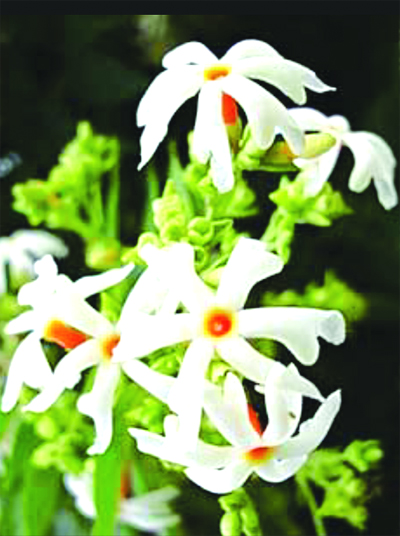Shashikant Lakhanpal
Palash is a traditional Indian medicinal tree. It is a native of India. It is associated with God of Fire [Agnidevta], culture, literature, religion and history of India. It has been used as medicine since the dawn of civilization in India.
The generic name Butea is given to the plant in the honour of Earl of Bute. But Indian names are more relevant and justifiable exhibiting relationship with birds like parrot [kinshuk], as the keel of the flower appears like the beak of parrot. Palash is visited by many other birds, one of them is Tesuari [Rosypaster], a bird that visits this tree in flocks.
Palash is a slow growing, dry season, deciduous tree about 15 metre tall. It grows throughout tropical and sub- tropical parts of Indian sub-continent, at an altitude of 1300-1400 metre. In J&K ,it grows in the hills of Katra, Reasi, Udhampur,Samba, Kathua ,Akhnoor& Palanwalla.
Trunk is usually crooked & twisted with irregular branches covered by rough and grey bark.
Leaves are pinnately 3- foliate, 10-20 cms long and shiny at the tip, brown below and hairy on the dorsal side. Hindi phrase ‘ Dhak ke teen paat’ , comes from prominent three leaflets of palash. Leaves are used in Shraadh for pind-dhaan by the Hindus, so is a sacred tree for Hindus. Leaves are not eaten as fodder by animals, are used by street food sellers to serve food placed on them. Leaf plates and bowls are made by joining many leaves or singly. Leaves are used as tonic and aphrodisiacs.
Flower comes first then the leaves. Palash is seen in all its ugliness in December and January when most of the leaves fall [ Deciduous], but in March to May it truly becomes a ‘Flame of the Forest’, a riot of orange red flowers growing in clusters on the leafless branches covering the entire crown. Flowers are scentless & are borne along the ends of the stalk. Each flower consists of five petals, comprising one stranded, two smaller wings and a very curved beak shaped keel. It is this keel which gives it the name of Kinshuk or Parrot Tree. Flowers are used to prepare a traditional eco-friendly Holi colours. This colour is also used for dyeing the clothes.
Cultural Significance
Palash prevalent in India stands widely adored and explored for its medicinal properties were first discovered here as well. Whole tree was used for various medicinal purposes by the Indians.
Plant has got its name to the town of Palashi, famous for its historic Battle of Plassey.
Name Palanwalla near Akhnoor got its name from the Palash growing in the area dominantly and is named in Dogri as Palaa.
Butea or Palash is associated with spring season especially through the poems and songs of Nobel Laureate Ravinder Nath Tagore, who linked its bright orange colour flowers to fire.
First shloka of Shukla Yajurveda speaks about Palash. In Sanskrit flower is used as symbol of the arrival of spring and the colour of love. Jayadeva in the Geta Govindam compares the colour of flowers of palash to the nails of Kamadeva[ cupid] with which he wounds the hearts of lovers.
Medicinal Properties of Palash
Palash is an excellent astringent, quench thirst, purify blood, coagulates blood, anti- pyretic, and relieves burning sensation. In Ayurveda treatise Acharya Charak and Sushruta mentioned the medicinal use of seeds and bark of palash. Chakradatta describe its gum as astringent and seeds as anti- parasitic.
Palash is considered as good tonic, anthelmintic, anti- inflammatory, antimicrobial, anti – diabetic, dieuretic, analegesic, antitumour, anti ovulatory, anti -conceptive and and anti- implantation properties.
Gum of the tree is a valuable drug because of its astringent qualities and used by leather workers because of its tannin. Gum is also used to cure diarrhaea.
Kamarkas , the hindi name of the gum when it solidifies ,is used as medicine and in food dishes.
Palash is a good insecticide as it kills mosquitoes when they are attracted by the colours and fragrance of the flowers. Eggs that laid into the liquid within the flowers with never hatch.any mosquito that touches the escape from it.
Leaves are useful in the management of leucorrhoea. A decoction prepared from them should be used to wash the genital parts regularly to cure the disease.
Palash is a good hair follicle re-juvinator. Himalaya has come up with anti- hair loss cream to increase the follicular density and tensile strength of hair under the trade name Palasha.
Kamarkas also improves irritable bowel syndrome and promote physical strength.
Extracts of roots is used to cure eye disorders, night blindness, and eye inflammation. If this extract is taken with triphala, controls obesity and semen disorders.It is also effective in curing urinary disorders, piles, anaemia, diabetes, and nasal bleeding. Root extract is also a good appetizer, cures flatulence of stomach. Extract of root is to stop involuntary flow of semen and enhances sexual vigour.
Seeds of palash are used as contraceptive. Decoction of seeds is also used to cure diarrhaea. Seed oil massage to sex organ cures impotency. Use of seed powder cures eczema and itching.
Powder of gum, bark ,flowers and dried buds is given to patient to cure dysuria.
Dried powder of whole plant delays ageing.
Precautions and Safety
Palash is a very safe medicinal plant. But, this should not be used without taking proper medical advice from a registered ayurvedic doctor.
(The author is Lecturer in Botany Govt SRML Model HSS Jammu)


